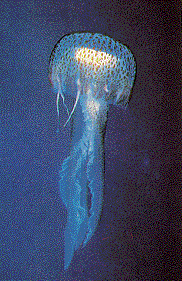

The phylum name comes from their ability to sting by discharging nematocysts.
This animation (Audio - Important) illustrates the function of a nematocyst.
The cnidarian body is not complex. There are two main body plans , the medusa and the polyp. The medusa resembles an umbrella and floats like a tentacle-fringed bell in the water. The polyp is tubelike and is usually attached to some substrate. It may be solitary or part of a colony.
The digestive cavity is saclike (only a mouth) and can accommodate prey larger than the cnidarian itself. True tissues include an outer epidermis and an inner gastrodermis (epithelial layers with a jellylike mesoglea between). There is a nerve net that coordinates sensory and motor activities.
Cnidarian life cycles show alternation of life stages. Reproduction may be sexual, with a planula larva stage, or it may be asexual. Gonads may be in the epidermis or gastrodermis.
This animation (Audio - Important) illustrates the life cycle of obelia.
This animation (Audio - Important) describes the body structure of cnidarians.
The Portugese man-o-war (Physalia) is a floating colony of specialized polyps and modified medusae.
Colonial anthozoans form coral reefs in warm seas.
Living coral video taken at the Monterey Bay Aquarium.
Jellyfish video taken at the Monterey Bay Aquarium.
Sea anenome and clown fish video (Audio - Not Important) taken in the Storer Hall Lobby.
REVIEW: �Jellyfishes, sea anemones, and their relatives have _____ symmetry, and their cells form _____ .�
REVIEW: �Which of the following phyla is characterized by radially symmetrical members?�
PREVIOUS
NEXT
LECTURE 15 INDEX
MAIN INDEX